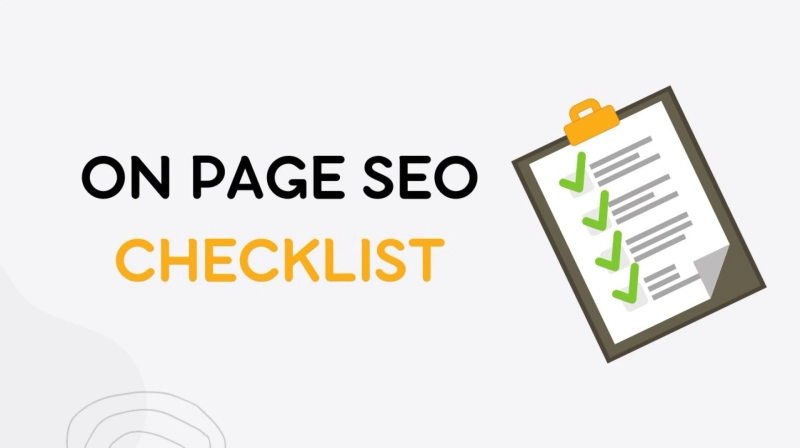In the dynamic world of digital marketing, on-page SEO remains a cornerstone for website success. It's not just about peppering your content with keywords; it's an art that balances user experience with search engine algorithms.
Whether you're a small business owner, a blogger, or an e-commerce giant, this ultimate on-page SEO checklist will guide you through optimizing your website for both users and search engines.
Let's get started!
What is On-Page SEO?
On-page SEO, also known as on-site SEO, is the practice of optimizing individual web pages in order to rank better in search engine results and attract more relevant visitors. It includes optimizing on-page elements such as content, title tags, meta descriptions, URLs, etc.
On-Page SEO Checklist
Here are some on-page SEO best practices that you can use to optimize our blog posts for higher ranking.
1) Identify Target Keywords
Identifying target keywords is the first step in any on-page SEO checklist.
Target keywords are the words or phrases users enter into search engines when they are looking for specific information or solutions. By identifying the right target keywords for your website, you can optimize your content to rank better in search results for those keywords.
You may use keyword research tools like SEMrush, Ahrefs, etc., to find what terms and phrases people use to find pages like yours.
2) Optimize Your Title Tags
The title tag is the page title that shows in the SERP. It should tell Google and users what your page is about. And entice users to click through.
The title tag is one of the important elements for on-page optimization. So make sure to include the target keywords (the main search term you want to rank for) at the beginning of your page title. This allows search engines to understand what keywords the page is targeting.
You can also add secondary keywords, too. But it is important to avoid unnatural “keyword stuffing.” This might look spammy to Google and its users.
Furthermore, your page title doesn’t have to be very long. You should keep it below 60 characters because Google cuts title tags that are too long.
3) Write Optimize Meta Description
A meta description is a snippet of text that appears below the page title in search engine results pages (SERPs).
However, meta-description is not a direct ranking factor. It is included in our on-page optimization checklist since it is essential to standing out on the SERP and attracting more clicks.
Use it to explain what users can expect from your page and why they should visit it. Also, make sure it includes your targeted keyword.
Furthermore, your meta description should be a maximum of 140 characters. If it is longer than 140 characters, Google truncates them in desktop and mobile SERPs.
4) Creating SEO-Friendly URLs
Creating SEO-friendly URLs is important for maximum SEO.
A good URL should be less than 255 characters and include hyphens ‘-‘ to separate the different parts.
An SEO-friendly URL, like the page title, is short, descriptive, and contains your targeted keyword.
5) Optimized Headings and Subheadings
Ensure that your main heading is wrapped in an H1 tag and includes the primary keyword.
Use subheadings to make your content scannable and incorporate secondary keywords.
6) Add Targeted Keywords in Your Body Content
Google uses keywords and context to see if a website is relevant to a certain keyword. If your body content does not include your target keyword, Google might think your page is irrelevant to the search.
When performing on-page optimization, add your primary keyword in the first paragraph. Then, repeat primary or secondary keywords throughout.
However, avoid keyword stuffing—i.e., repeatedly use the same keywords (or phrases) in your website’s content.
7) Add Internal Links
Internal links are hyperlinks that connect one page of a website to another page on the same website. It helps Google find, index, and understand all of the important pages on your website.
Further, if you use them properly, internal links can send page authority (also known as PageRank) to important pages.
In short, internal links are important if you want higher rankings in Google. So, always add internal links from other relevant pages whenever you publish new content.
8) Add External Links
An external link is one that leads to a page that is not on your website but on another domain. It is the opposite of an internal link, which links to URLs within the same domain.
In terms of SEO, an external link on one site counts as a backlink to another site, and backlinks are one of Google’s most essential ranking factors. External links pass link equity and help connected pages rank higher.
Furthermore, linking to trustworthy websites might boost your page authority and trustworthiness in Google’s eyes.
Make sure to link out to 2-3 authority sites in your article.
9) Optimize Your Images
Content is more than just text. That is why images are an important on-page SEO factor.
Remember that each image on your website should have an alt text.
Furthermore, use image optimization tools to compress images for faster loading times without sacrificing quality.
10) Apply Schema Markup
Schema markup, often known as structured data, is a coding language that “tells” Google more about your site’s different types of data. And the more Google knows your page, the more properly it can rank it.
Google also uses similar pieces of code to create rich results (or “rich snippets”).
Conclusion
Optimizing your website for on-page SEO is essential for improving your search engine rankings and increasing organic traffic.
By following the on-page SEO checklist, you can ensure that your website is optimized for the right keywords, has high-quality content, a clear and structured layout, and meets all technical requirements.
Remember that search engines are continuously changing. As a result, it’s important to stay up-to-date with the latest SEO best practices and regularly review and update your website’s on-page SEO.
We hope you find this ultimate on-page SEO checklist helpful.


